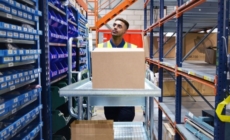-
Tower Launches Customer Sustainability Hub with Practical Tools for Lower-Impact Pharmaceutical Cold Chain - October 16, 2024
-
Six decision-making models for best practice WMS digital transformation - October 16, 2024
-
“Transforming Logistics: Precision and Purpose” – BIFA takes centre stage - October 15, 2024
-
JAMES JONES & SONS LTD EXPANDS ITS PALLETS & PACKAGING DIVISION THROUGH THE ACQUISITION OF HG TIMBER LTD - October 10, 2024
-
HUGO BECK EXPANDS MACHINE RANGE FOR E-COMMERCE, MAIL ORDER AND LOGISTICS - October 10, 2024
-
Winning Irish Exporter of the Year, Combilifts CEO Martin McVicar talks about the journey into the Global Market - October 8, 2024
-
JAMES JONES & SONS’ AUSTRALIAN SUBSIDIARY, HYNE GROUP, EXPANDS TO WESTERN AUSTRALIA - October 3, 2024
-
QUECLINK LAUNCHES SOLAR-POWERED ASSET TRACKER FOR TRAILERS AND CONTAINERS - October 3, 2024
-
Southgate Global Calls for Greater Health and Safety in the Warehouse Back Care Awareness Week - October 3, 2024
-
Nulogy to Expand Capabilities with Strategic Acquisition of Mingo Smart Factory - October 3, 2024
Self-Storage Boom Reflects The Need For Racking Upgrades
If you’ve got an overflowing attic or a crippling addiction to collecting random tat, it’s likely that you’re all too familiar with the phenomenon of self-storage. These colossal facilities now inhabit cities and business parks across the country, offering everyone the opportunity to tuck away their belongings in return for a regular fee.
With the service proving as useful to small businesses as it does to regular consumers, there seems to be no end in sight for the industry’s growth. Yet Brexit – and the relentless march of eCommerce – could easily put a spanner in the works. The issue will be how facility owners manage this growth when land is at a premium – and how they distinguish their services when the industry proves even more popular.
Storage success
We aren’t just saying there’s a boom because it suits us – the data is there to back it up. UK self-storage businesses added 70 sites in 2018, with a total footprint of 45 million sq/ft. The industry now turns over £750 million each year, and is so sought after that storage in the heart of London is now more expensive than some of the capital’s most sought after office space.
Elsewhere, Britain’s largest self-storage provider reported record profits in 2018, with demand apparently surging in both the UK and France. Safestore’s portfolio of properties gained some £122 million in revaluations, reflecting the growing value of land as warehouse space becomes more sought after. Their like-for-like sales were also up by more than 5%, however, with the company opening several new sites in London and Paris, and planning more for this year.
Driving this growth is a hearty mixture of individuals and businesses, who are opting to store stock, documents and other items off-site, rather than expanding their own storage capacity. Welsh firm Storage Giant claims to have more than 900 SMEs using its storage service, employing some 5,000 people between them. According to its CEO, business owners are being priced out of adding new storage capacity by high business rates and rent, and are attracted by the flexible terms of self-storage.
Internal vs external
There are numerous document storage companies who provide a sterling service to their clients, storing tens or hundreds of thousands of boxes in some cases. Outsourcing this kind of archive storage makes sense, as these are often backups of important documents which benefit from being off-site, where damage in your own facility can’t affect them.
Self-storage also makes sense for many small businesses, who have limited space on their premises to keep things like additional stock. While a cost comparison between self-storage and upgrading your own facility is always worthwhile, there are many instances in which it simply isn’t economical for a small business to move or expand in order to hold more stock, particularly if it is seasonal, or demand is difficult to predict.
For larger businesses who still rely on self-storage for overflow, however, this cost comparison may come out differently. Many business owners look at their existing warehouse or storeroom space and see only the full shelves and aisles, without realising that these spaces could be optimised to hold more goods. Others worry that the process of adding more storage or replacing existing racks will be disruptive, piling on the costs.
When to upgrade your storage
Although most self-storage companies offer special business rates, they will depend on the kinds of items you intend to store. Some goods may also not be suitable for self-storage, and you may have to take out additional insurance to cover them. You will also have to factor in the cost of retrieval, which will naturally be greater than if the items remained with you on site.
One of the key considerations for British firms currently using self-storage is the impact of Brexit. With storage already at a premium thanks to expansion by eCommerce firms, the stockpiling of goods for Brexit has led to further shortages. In the event of a ‘no deal’ Brexit, this may be set to continue, as goods have to be bought in larger batches to accommodate customs delays. Land is also becoming more expensive, and business rates have risen in recent years, increasing the cost of a new facility.
Improving your current storage solution now is an ideal way to mitigate these threats, and prepare your business for whatever the next few years can throw at it. An array of high density racking options provide all manner of different ways to store and retrieve items, from small goods to large pallets. Narrow aisle pallet racking for instance can increase the available storage space in a facility by as much as 50% – preparing you for the long term, and shielding you against any price rises by self-storage firms.
Self-storage and safety
An issue which we may see more of amongst self-storage firms is the safety of the facilities, and their suitability to store a wide variety of items. A recent case involving a self-storage facility in Croydon saw the whole place go up in flames, destroying millions of pounds of stored items, including many priceless heirlooms and family artefacts. Early reports suggest the facility lacked sprinklers, and that bays were poorly segmented, with gaps above each locker allowing the fire to spread quickly between them.
Inadequate safety features and fire protection systems are issues common to all-too-many businesses, and should not be taken as a sign that self-storage is unsafe. However, this incident does perhaps reflect the lack of attention paid to this growing industry, and the ease of assuming that because a company runs a large and impressive facility, it is bound to be safe and secure. Further fires could damage the public perception of the self-storage industry, and pose a risk to the majority of responsible companies as well as the opportunists.
What this highlights is a need for self-storage firms to set themselves apart by triumphing safety as an integral feature. Passive and active fire protection, including elements such as fire rated partitions and doors, sprinklers and VESDA smoke detection systems should become industry standard terminology, used not just internally but in marketing materials. By installing these systems and championing their use, the self-storage industry can inoculate itself against these concerns, and continue to build on its stellar year of success.
James Beale is the Operations Manager at Invicta Pallet Racking. For over 25 years Invicta has been at the forefront of the archive storage industry throughout the UK and Europe, designing and installing some of the largest pallet racking and storage systems currently found on the market.































